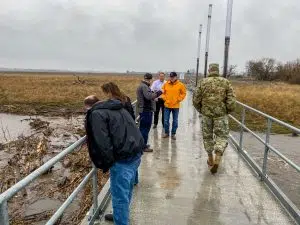
Update 3:45 PM:
An engineer heading planned reconstruction of an aging dam in northeast North Dakota warned Gov. Burgum today (Mon) that upcoming rainfall could add pressure to the earthen structure already weakened by flooding.
Zach Hermann, of Fargo-based Houston Engineering, told Burgum and other state and local officials that he hopes the predicted precipitation will be spread out and not affect stabilization efforts on the 65-year-old Bourbanis Dam upstream of Cavalier.
Last week, the North Dakota National Guard’s Black Hawk helicopters dropped more than 200 1-ton sandbags on the dam. The Minnesota National Guard’s Chinook helicopter placed two 5-ton water pumps capable of pumping 4,000 gallons per minute.
Burgum today (Mon) surveyed flood response and recovery in northeast North Dakota. He also visited the Renwick Dam at Icelandic State Park…and the city of Grafton.
AP
= =
Update 3:00 PM:
Gov. Doug Burgum today surveyed flooding in northeast North Dakota, meeting with local leaders on flood response and recovery, including efforts to stabilize the Bourbanis Dam upstream of Cavalier.
The governor was joined by Maj. Gen. Al Dohrmann, adjutant general of the North Dakota National Guard and director of the state Department of Emergency Services, North Dakota Homeland Security Director Darin Hanson and Department of Water Resources Director Andrea Travnicek as they met with Cavalier Mayor Lacey Hinkle, state Rep. David Monson and other local officials in Cavalier for a briefing on flood fighting efforts and discussion about future flood protection needs.
“We’re deeply grateful for the outstanding local leadership during this historic flood fight, with dozens of local, state and federal agencies collaborating with hundreds of volunteers to protect lives and property in northeast North Dakota,” Burgum said. “Thanks to their valiant efforts, communities are holding their own but remain at risk from widespread overland flooding and swollen dams and waterways, with rivers still yet to crest in cities like Pembina and Drayton. The State of North Dakota will continue to bring a whole-of-government approach to helping local governments fight floods while also supporting efforts to make their communities more resilient against flooding and other natural disasters in the long-term.”
During a roundtable discussion at the American Legion in Cavalier, local officials gave an update on efforts to stabilize the Bourbanis Dam. Last week, the North Dakota National Guard helped slow erosion of the earthen dam by using two Black Hawk helicopters to place 213 1-ton sandbags. On Friday, the Minnesota National Guard responded to an Emergency Management Assistance Compact request from North Dakota, providing a Chinook helicopter that strategically placed two 5-ton water pumps capable of pumping 4,000 gallons per minute to relieve pressure on the dam.
“We’re currently just trying to get water out of the dam as quickly as possible,” said Zach Herrmann of Houston Engineering, engineer for the Pembina County Water Resource Board. He noted repairs and improvements are planned once the water level drops, and officials are hoping this week’s rainfall comes slowly enough to manage the situation with what’s in place. “We’re definitely not out of the woods with Bourbanis Dam yet.”
After the roundtable, Burgum toured Renwick Dam at Icelandic State Park west of Cavalier. The dam underwent an $8.9 million rehabilitation project partially funded by the state in 2013 and has performed well during the current flood, officials said.
In Grafton, Mayor Chris West and project manager Jon Markusen of KLJ showed Burgum how a diversion project completed last year is protecting the city from the swollen Park River and overland flooding. The $48 million project, being paid for with a combination of local and state funding including $32 million from the State Water Commission, includes a 3.2-mile bypass channel, 12 miles of tieback levees and a control structure.
West said the diversion is working “phenomenally,” while also expressing concern for outlying communities and rural areas that continue to face challenges.
Burgum declared a statewide emergency on April 25 after severe spring storms April 22-24 brought heavy rains and snowmelt that swelled creeks and rivers within the Sheyenne and Red River basins and swamped fields and ditches, causing overland flooding and inundating rural roads and state highways. The storms also brought freezing rain and snow to western North Dakota, toppling thousands of utility poles and knocking out power to thousands of residents.
The emergency declaration sets the stage for requesting a presidential disaster declaration, which if granted would unlock FEMA public assistance to help cities, counties and townships pay for the cost repairs to utilities, roads and other infrastructure. Hanson, the Homeland Security director, urged local officials to document their costs for reimbursement, noting the cost-share on a presidential declaration would be 10% state, 75% federal and 15% local.
The request for a presidential declaration will be submitted after rivers crest and initial damage assessments are completed. North Dakota’s infrastructure damage threshold for receiving a presidential declaration is approximately $1.3 million statewide.
“We do expect we should easily meet the threshold,” Hanson said.
(Photo: Gov. Burgum’s office)
= =
Original story:
Gov. Doug Burgum will survey flooding in northeast North Dakota today (Monday) and meet with local leaders from Grafton and Cavalier about flood impacts and response.
Last week, the North Dakota National Guard helped stabilize the Bourbanis Dam by using two Black Hawk helicopters to place 213 1-ton sandbags over two days. On Friday, the Minnesota National Guard also responded to an Emergency Management Assistance Compact request and provided a Chinook helicopter that strategically placed two 5-ton water pumps capable of pumping 4,000 gallons per minute to relieve pressure on the dam.
Burgum declared a statewide emergency on April 25 after severe spring storms brought heavy rains and snowmelt that swelled creeks and rivers within the Sheyenne and Red River basins.
The emergency declaration sets the stage for a possible presidential disaster declaration
— — —
The Red River continues a roller coaster ride this spring. After a second crest last week the “Red” is expected to fall below moderate flood stage of 40 feet in Grand Forks / East Grand Forks tonight (Monday). The potential for heavy rain could push the river back up again to 41.5 feet by mid-week. Flood stage is 28. The National Weather Service has posted Flood Warnings for all or parts of 17 counties.





FOLLOW US FOR INSTANT UPDATES!
 (KNOX) – ENTER YOUR STORY HERE. Click the image on the left to replace. Be sure to use MEDIUM size and choose left alignment. Don’t forget to also add the image in featured media and select no image.
(KNOX) – ENTER YOUR STORY HERE. Click the image on the left to replace. Be sure to use MEDIUM size and choose left alignment. Don’t forget to also add the image in featured media and select no image.










